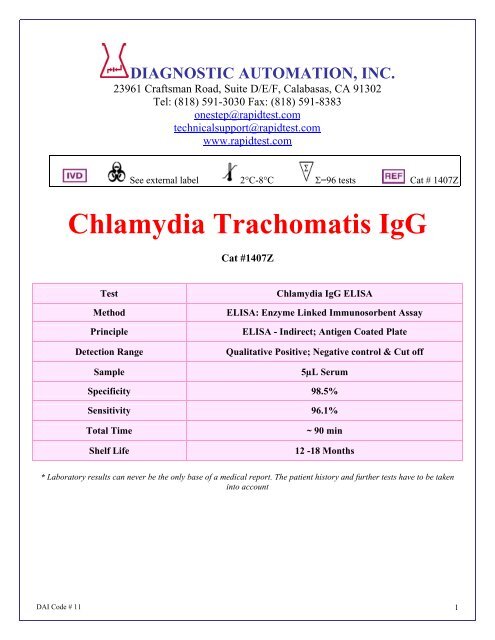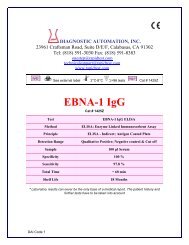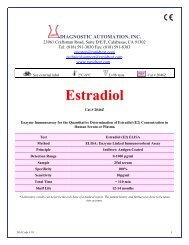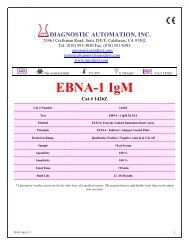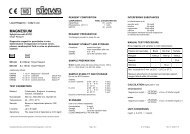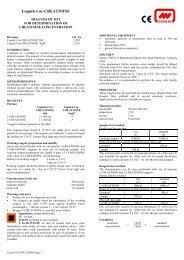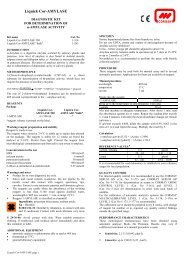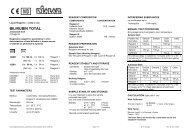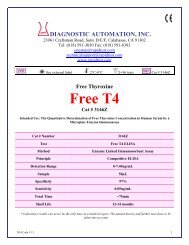Chlamydia Trachomatis IgG
Chlamydia Trachomatis IgG
Chlamydia Trachomatis IgG
Create successful ePaper yourself
Turn your PDF publications into a flip-book with our unique Google optimized e-Paper software.
DIAGNOSTIC AUTOMATION, INC.<br />
23961 Craftsman Road, Suite D/E/F, Calabasas, CA 91302<br />
Tel: (818) 591-3030 Fax: (818) 591-8383<br />
onestep@rapidtest.com<br />
technicalsupport@rapidtest.com<br />
www.rapidtest.com<br />
See external label 2°C-8°C Σ=96 tests Cat # 1407Z<br />
<strong>Chlamydia</strong> <strong>Trachomatis</strong> <strong>IgG</strong><br />
Cat #1407Z<br />
Test<br />
Method<br />
Principle<br />
Detection Range<br />
Sample<br />
<strong>Chlamydia</strong> <strong>IgG</strong> ELISA<br />
ELISA: Enzyme Linked Immunosorbent Assay<br />
ELISA - Indirect; Antigen Coated Plate<br />
Qualitative Positive; Negative control & Cut off<br />
5µL Serum<br />
Specificity 98.5%<br />
Sensitivity 96.1%<br />
Total Time<br />
Shelf Life<br />
~ 90 min<br />
12 -18 Months<br />
* Laboratory results can never be the only base of a medical report. The patient history and further tests have to be taken<br />
into account<br />
DAI Code # 11 1
NAME AND INTENDED USE<br />
The Diagnostic Automation ELISA, <strong>Chlamydia</strong> <strong>Trachomatis</strong> <strong>IgG</strong> is intended for use in evaluating a patient's<br />
serologic status to <strong>Chlamydia</strong> <strong>Trachomatis</strong> infection. It is also used to evaluate paired sera for the<br />
presence of a significant increase in specific <strong>IgG</strong> as indicative of a recent or current <strong>Chlamydia</strong><br />
<strong>Trachomatis</strong> infection.<br />
SUMMARY AND EXPLANATION OF THE TEST<br />
<strong>Chlamydia</strong> <strong>Trachomatis</strong> is one of the most common human pathogens. Of the 15 recognized serotypes, 4<br />
(A, B, Ba, and C) have been shown to cause hyperendemic blinding trachoma, a disease which afflicts<br />
hundreds of millions of people in developing countries. Three serotypes (L-1, L-2, and L-3) are the causes<br />
of lymphogranuloma venereum (LGV), a sexually transmitted systemic disease. The other serotypes (D<br />
through K) have been associated with genital tract infections and sporadic cases of conjunctivitis in<br />
industrialized societies. These agents are the major recognized cause of nongonococcal urethritis in men,<br />
in whom they may also cause epididymitis. In women, C. trachomatis causes cervicitis and has been<br />
associated with acute salpingitis. Infants born through an infected birth canal may contract the infection<br />
and then develop inclusion conjunctivitis of the newborn and/or the characteristic chlamydial pneumonia<br />
syndrome.<br />
High levels of anti-<strong>Chlamydia</strong> <strong>IgG</strong> antibody are of diagnostic value in chronic or systemic infections such as<br />
salpingitis, mechanical infertility, perihepatitis, epididymitis, Reiter’s syndrome and pneumonitis.<br />
DIAGNOSTIC AUTOMATION ELISA <strong>Chlamydia</strong> <strong>Trachomatis</strong> test employs the LGV type 2 broadly reacting<br />
antigen of <strong>Chlamydia</strong> <strong>Trachomatis</strong>. It will detect <strong>Chlamydia</strong> <strong>Trachomatis</strong>, <strong>Chlamydia</strong> Psittaci and<br />
<strong>Chlamydia</strong> Pneumoniae (TWAR) antibodies.<br />
PRINCIPLE OF THE TEST<br />
Purified <strong>Chlamydia</strong> <strong>Trachomatis</strong> antigen is coated on the surface of microwells. Diluted patient serum is<br />
added to wells, and the <strong>Chlamydia</strong> <strong>Trachomatis</strong> <strong>IgG</strong> specific antibody, if present, binds to the antigen. All<br />
unbound materials are washed away. After adding enzyme conjugate, it binds to the antibody-antigen<br />
complex. Excess enzyme conjugate is washed off, and TMB Chromogenic Substrate is added. The<br />
enzyme conjugate catalytic reaction is stopped at a specific time. The intensity of the color generated is<br />
proportional to the amount of <strong>IgG</strong> specific antibody in the sample. The results are read by a microwell<br />
reader compared in a parallel manner with calibrator and controls.<br />
MATERIAL PROVIDED<br />
1. Microwell Strips: <strong>Chlamydia</strong> trachomatis antigen coated wells (12 X 8 wells)<br />
2. Sample Diluent: Blue color solution 1 Vial (22 mL)<br />
3. Calibrator: Factor Value (f) stated on label. Red Cap 1 Vial (150 µL)<br />
4. Negative Control: Range Stated on label. Naturaln Cap 1 Vial (150 µL)<br />
5. Positive Control: Range Stated on label. Green Cap 1 Vial (150 µL)<br />
6. Washing Concentrate 10X: White Cap 1 bottle ( 100 mL)<br />
7. Enzyme Conjugate: Red color solution 1 Vial (12 mL)<br />
8. TMB Chromogenic Substrate: Amber bottle 1 Vial (12 mL)<br />
9. Stop Solution 1 Vial (12 mL)<br />
DAI Code # 11 2
STORAGE AND STABILITY<br />
1. Store the kit at 2 - 8 °C.<br />
2. Always keep microwells tightly sealed in pouch with desiccants. We recommend you use up all wells<br />
within 4 weeks after initial opening of the pouch.<br />
3. The reagents are stable until expiration of the kit.<br />
4. Do not expose test reagents to heat, sun or strong light during storage or usage.<br />
WARNINGS AND PRECAUTIONS<br />
1. Potential biohazardous materials:<br />
The calibrator and controls contain human source components which have been tested and found<br />
nonreactive for hepatitis B surface antigen as well as HIV antibody with FDA licensed reagents.<br />
However, as there is no test method that can offer complete assurance that HIV, Hepatitis B virus or<br />
other infectious agents are absent, these reagents should be handled at the Biosafety Level 2, as<br />
recommended in the Centers for Disease Control/National Institutes of Health manual, "Biosafety in<br />
Microbiological and Biomedical Laboratories." 1984<br />
2. Do not pipette by mouth. Do not smoke, eat, or drink in the areas in which specimens or kit reagents<br />
are handled.<br />
3. The components in this kit are intended for use as a integral unit. The components of different lots<br />
should not be mixed.<br />
4. This product contains components preserved with sodium azide. Sodium azide may react with lead<br />
and copper plumbing to form explosive metal azide. On disposal, flush with a large volume of water.<br />
SPECIMEN COLLECTION AND HANDLING<br />
1. Collect blood specimens and separate the serum.<br />
2. Specimens may be refrigerated at 2 - 8 °C for up to seven days or frozen for up to six months. Avoid<br />
repetitive freezing and thawing of serum sample.<br />
PREPARATION FOR ASSAY<br />
1. Prepare 1x washing buffer. Prepare washing buffer by adding distilled or deionized water to<br />
10x wash concentrate to a final volume of 1 liter.<br />
2. Bring all specimens and kit reagents to room temperature (20-25 °C) and gently mix.<br />
ASSAY PROCEDURE<br />
1. Place the desired number of coated strips into the holder.<br />
2. Prepare 1:40 dilutions by adding 5 µl of the test samples, negative control, positive control, and<br />
calibrator to 200 µl of sample diluent. Mix well.<br />
3. Dispense 100 µl of diluted sera, calibrator, and controls into the appropriate wells. For the reagent<br />
blank, dispense 100 µl sample diluent in 1A well position. Tap the holder to remove air bubbles from<br />
the liquid and mix well. Incubate for 30 minutes at room temperature.<br />
4. Remove liquid from all wells. Repeat washing three times with washing buffer.<br />
5. Dispense 100 µl of enzyme conjugate to each well and incubate for 30 minutes at room temperature.<br />
6. Remove enzyme conjugate from all wells. Repeat washing three times with washing buffer.<br />
7. Dispense 100 µl of TMB Chromogenic Substrate to each well and incubate for 30 minutes at room<br />
temperature.<br />
8. Add 100 µl of 2 N HCl to stop reaction.<br />
Make sure there are no air bubbles in each well before reading<br />
9. Read O.D. at 450 nm with a microwell reader.<br />
DAI Code # 11 3
CALCULATION OF RESULTS<br />
1. To obtain cut off OD Value: Multiply the OD of calibrator by factor (f) printed on label calibrator.<br />
2. Calculate the <strong>Chlamydia</strong> <strong>IgG</strong> Index of each determination by dividing the OD value of each sample by<br />
obtained OD value of Cut-off.<br />
For Example:<br />
If Factor (f) value on label = 0.4<br />
Obtained Calibrator O.D = 1.100<br />
Cut off O.D = 1.100 X 0.4 = 0.44 (by definition <strong>Chlamydia</strong> <strong>IgG</strong> Index = 1)<br />
Patient sample O.D = 0.580<br />
<strong>Chlamydia</strong> <strong>IgG</strong> Index = 0.580/0.44 = 1.32 (Positive Result)<br />
Patient Sample O.D = 0.320<br />
<strong>Chlamydia</strong> <strong>IgG</strong> Index = 0.320 / 0/44 = 0.73 (Negative Result)<br />
QUALITY CONTROL<br />
The test run may be considered valid provided the following criteria are met:<br />
1. The O.D. value of the reagent blank against air from a microwell reader should be less than 0.250.<br />
2. If the O.D. value of the Calibrator is lower than 0.250, the test is not valid and must be repeated.<br />
3. The <strong>IgG</strong> Index for Negative and Positive Control should be in the range stated on the labels.<br />
INTERPRETATION<br />
Negative: <strong>IgG</strong> Index of 0.90 or less are seronegative for <strong>IgG</strong> antibody.<br />
Equivocal:<br />
Positive:<br />
<strong>IgG</strong> Index of 0.91 - 0.99 are equivocal. Sample should be retested.<br />
<strong>IgG</strong> Index of 1.00 or greater.<br />
Expected Values: 230 random samples were determined with DIAGNOSTIC AUTOMATION microwell<br />
ELISA. <strong>Chlamydia</strong> <strong>Trachomatis</strong> <strong>IgG</strong>. The test results were computed as <strong>IgG</strong> Index using a chosen<br />
reference serum (cut off) as <strong>IgG</strong> index 1. The distribution of frequency versus <strong>IgG</strong> Index is presented as<br />
the following: 29 were found to be positive (12.6%), and 196 were found to be negative (85.2%).Histogram<br />
of <strong>Chlamydia</strong> T. <strong>IgG</strong> Index Total samples n=230<br />
DAI Code # 11 4
LIMITATIONS OF THE PROCEDURE<br />
1. A single serum sample cannot be used to determine recent infection.<br />
2. A serum specimen taken in an early stage during acute phase of infection may contain low levels of<br />
<strong>IgG</strong> antibody and render an <strong>IgG</strong> Index result negative.<br />
3. As with other serological assays, the results of these assays should be used in conjunction with<br />
information available from clinical evaluation and other diagnostic procedures.<br />
PERFORMANCE CHARACTERISTICS<br />
Sensitivity and Specificity:<br />
Sensitivity, specificity and accuracy were evaluated using a commercial available ELISA kit on 104<br />
specimens. The correlation results are summarized in the following table:<br />
Reference ELISA<br />
N P Total<br />
DIAGNOSTIC N 69(D) 3 (B) 72<br />
AUTOMATION P 1(C) 31 (A) 32<br />
ELISA Total 70 34 104<br />
Sensitivity = A / (A+B) = 31 / (31+3) = 91.1%<br />
Specificity = 69 / (69+1) = 98.5%<br />
Accuracy (Overall agreement) = (A+D) / (A+B+C+D) = 100 / 104 = 96.1%<br />
Precision:<br />
The precision of the assay was evaluated by testing three different sera eight replicates on 3 days. The<br />
intra-assay and inter-assay C.V. are summarized below:<br />
N = 8 Negative Low positive Positive<br />
Intra-assay 10.9% 10.5% 8.9%<br />
Inter-assay 12.3% 11.1% 10.5%<br />
Cross-reactivity:<br />
A study was performed to determine the cross-reactivity of the test to the following antibodies:<br />
1. <strong>IgG</strong> of EBV, Mumps, Measle, and VZV.<br />
2. <strong>IgG</strong> and IgM of Rubella, Toxo, CMV, HSV 1, and HSV 2.<br />
3. IgM of RF.<br />
4. <strong>IgG</strong> of ANA, anti- ds DNA.<br />
All positive samples tested give negative results.<br />
REFERENCES<br />
1. Schachter, J. 1978. <strong>Chlamydia</strong>l infections. N. Engl. J. Med. 298: 428-435, 490-495, 540-549.<br />
2. Sarov, I., Kleinman, D., Cevenini, R., Holoberg, G., Potashnik, G. Sarov, B. and Insler, V. (1986).<br />
Specific <strong>IgG</strong> and IgA Antibodies to <strong>Chlamydia</strong> trachomatis in Infertile Women. Int. J. Fertil 31: 193-<br />
DAI Code # 11 5
197.<br />
3. Kaneti, J. et al. (1988). <strong>IgG</strong> and IgA Antibodies specific for Chlymydia trachomatis in Acute<br />
Epididymitis. Europ. Urol. 14: 323-327.<br />
4. Kletter, Y., Caspi, D., Yarom, M., Sarov, B., Sarov, I. And Tanay. A. Serum IgA and <strong>IgG</strong> Antibodies<br />
Specific to <strong>Chlamydia</strong> in Patients with Rieter’s Syndrome (RS). In: Proceedings of The European<br />
Society for <strong>Chlamydia</strong> Research, Societa Editrice Esculapio, Bologna. 1988. P. 170.<br />
5. Paran, H., Heimer, D. and Sarov, I. (1986). Serological, Clinica and Radiological Findings in Adults<br />
with Bronchopulmonary Infections Caused by <strong>Chlamydia</strong> trachomatis. Isr. J. Med. Sci. 22: 823-827.<br />
SUMMARY OF ASSAY PROCEDURE<br />
Step (20-25°C Room temp.) Volume Incubation time<br />
1 Sample dilution 1:40 = 5 µl / 200 µl<br />
2 Diluted samples, calibrator & controls 100 µl 30 minutes<br />
3 Washing buffer (3 times) 350 µl<br />
4 Enzyme conjugate 100 µl 30 minutes<br />
5 Washing buffer (3 times) 350 µl<br />
6 TMB Chromogenic Substrate 100 µl 30 minutes<br />
7 Stop solution 100 µl<br />
8 Reading OD 450 nm<br />
Date Adopted Reference No.<br />
2010-10-28 DA-<strong>Chlamydia</strong> <strong>IgG</strong>-2010<br />
DIAGNOSTIC AUTOMATION, INC.<br />
23961 Craftsman Road, Suite D/E/F, Calabasas, CA 91302<br />
Tel: (818) 591-3030 Fax: (818) 591-8383<br />
ISO 13485-2003<br />
Revision Date: 11-03-2010<br />
DAI Code # 11 6


